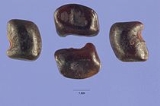
Aeschynomene rudis
Encyclopedia
Aeschynomene rudis is a species of flowering plant in the legume family
known by the common name zigzag jointvetch. It is native to South America but it is known from other continents, including North America, as a noxious weed, especially of wet areas such as rice fields
. It is aquatic
or semi-aquatic, growing bristly, glandular stems near or in water. It grows up to two meters tall. The leaves are composed of oval-shaped leaflets each about a centimeter long. At the base of each leaf are large, flat, pointed stipule
s. The flower is purple-tinted white and 1 to 1.5 centimeters wide. The fruit is a lobed, gland-dotted legume pod narrowed between the seeds. It is up to 5 centimeters long and less than one wide. As the pod dries it breaks into segments, each segment containing a seed. The hard, shiny seed is kidney-shaped and 2 or 3 millimeters long.
Fabaceae
The Fabaceae or Leguminosae, commonly known as the legume, pea, or bean family, is a large and economically important family of flowering plants. The group is the third largest land plant family, behind only the Orchidaceae and Asteraceae, with 730 genera and over 19,400 species...
known by the common name zigzag jointvetch. It is native to South America but it is known from other continents, including North America, as a noxious weed, especially of wet areas such as rice fields
Paddy field
A paddy field is a flooded parcel of arable land used for growing rice and other semiaquatic crops. Paddy fields are a typical feature of rice farming in east, south and southeast Asia. Paddies can be built into steep hillsides as terraces and adjacent to depressed or steeply sloped features such...
. It is aquatic
Aquatic plant
Aquatic plants are plants that have adapted to living in aquatic environments. They are also referred to as hydrophytes or aquatic macrophytes. These plants require special adaptations for living submerged in water, or at the water's surface. Aquatic plants can only grow in water or in soil that is...
or semi-aquatic, growing bristly, glandular stems near or in water. It grows up to two meters tall. The leaves are composed of oval-shaped leaflets each about a centimeter long. At the base of each leaf are large, flat, pointed stipule
Stipule
In botany, stipule is a term coined by Linnaeus which refers to outgrowths borne on either side of the base of a leafstalk...
s. The flower is purple-tinted white and 1 to 1.5 centimeters wide. The fruit is a lobed, gland-dotted legume pod narrowed between the seeds. It is up to 5 centimeters long and less than one wide. As the pod dries it breaks into segments, each segment containing a seed. The hard, shiny seed is kidney-shaped and 2 or 3 millimeters long.

